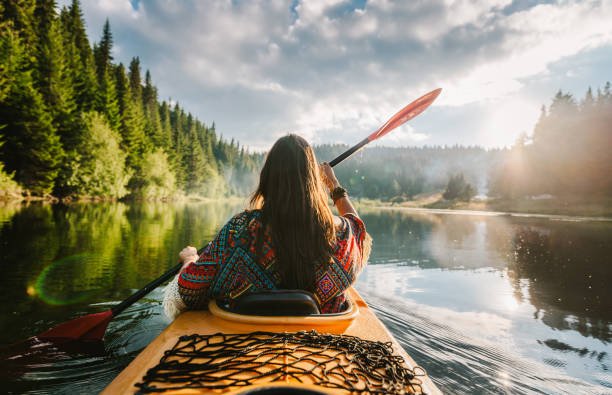Tips for Staying Safe in the Wilderness
Venturing into the wilderness can be an exhilarating experience, but it’s crucial to prioritize safety. Embarking on a journey into the wild offers unparalleled opportunities for exploration and discovery. However, without proper preparation and knowledge, it can also pose significant risks to your safety. In this comprehensive guide, we’ll delve into the ten essential tips for staying safe in the wilderness, equipping you with the know-how to navigate and thrive in nature’s untamed beauty.

1. Proper Planning and Preparation
Before embarking on any wilderness excursion, thorough planning and preparation are crucial. Research the area you’ll be visiting, familiarize yourself with the terrain, and check weather forecasts. Create a detailed itinerary, share it with a trusted friend or family member, and ensure you have all necessary supplies, including navigation tools, first aid kits, and sufficient food and water.
2. Packing the Right Gear
A well-prepared backpack can mean the difference between a successful adventure and a potentially dangerous situation. Ensure you’re equipped with navigation tools such as :
-
- Navigation tools: Tools such as a map, compass, or GPS device are essential for finding your way in unfamiliar terrain.
-
- First aid kit: A comprehensive kit containing bandages, antiseptic wipes, pain relievers, and other medical supplies is crucial for treating injuries and illnesses.
-
- Extra clothing: Packing extra layers of clothing helps you stay warm and dry in changing weather conditions.
-
- Food: Carrying non-perishable food items provides sustenance during extended outdoor adventures.
-
- Water: Hydration is key for maintaining energy and preventing dehydration, so carrying an ample supply of water or means to purify water sources is vital.

3. Stay Hydrated
Proper hydration is essential for maintaining optimal health and performance, especially in the wilderness where access to clean water may be limited. Carry an adequate supply of water and utilize purification methods such as filtration or chemical treatment to safeguard against waterborne pathogens.
4. Navigational Skills
Even with modern technological advancements, possessing basic navigational skills is invaluable when exploring remote areas. Familiarize yourself with map reading and compass use, and pay close attention to landmarks and topographical features to prevent getting lost. Learn how to use a map and compass proficiently, and consider bringing a GPS device as a backup. Pay attention to landmarks and natural features, and always have a backup plan in case of unexpected deviations from your route.
5. Weather Awareness
Weather conditions in the wilderness can change rapidly, posing significant challenges to outdoor enthusiasts. Stay informed by checking weather forecasts before your journey, and be vigilant for signs of impending weather changes while on the trail. Prepare accordingly by packing appropriate clothing and gear for varying conditions.
-
- Checking weather forecasts: Keeping abreast of upcoming weather patterns helps you anticipate potential hazards and plan accordingly.
-
- Vigilance for signs: Being observant of cloud formations, wind shifts, and other atmospheric cues can alert you to impending weather changes.
-
- Packing appropriate clothing: Having clothing suitable for both warm and cold weather ensures comfort and safety in any conditions.
-
- Gear for varying conditions: Equip yourself with gear like rain jackets, insulated layers, and waterproof footwear to withstand changing weather conditions effectively
6. Shelter Building
In the wilderness, having a shelter can mean the difference between survival and exposure to the elements. Learn how to construct simple shelters using natural materials such as branches, leaves, and rocks. A well-built shelter can provide protection from rain, wind, and extreme temperatures, ensuring your safety and comfort in the wilderness.
-
- Constructing simple shelters: Knowing how to build shelters using natural materials ensures a basic level of protection and comfort in the wilderness.
-
- Using natural materials: Utilizing branches, leaves, and rocks allows for the creation of makeshift shelters that blend seamlessly with the environment.
-
- Protection from elements: A well-built shelter offers refuge from rain, wind, and extreme temperatures, helping to maintain body temperature and prevent hypothermia or heat-related illnesses.

7. Wildlife Encounters
Encounters with wildlife are a natural part of wilderness exploration but can pose risks if mishandled. Educate yourself about the native wildlife species in the area you’re exploring and learn how to coexist safely. Respect wildlife’s natural habitat, maintain a safe distance, and avoid provoking or feeding animals.
-
- Educating yourself about native species: Understanding the behavior and habitats of local wildlife enhances safety during encounters.
-
- Learning to coexist safely: Knowing how to respect wildlife and their space reduces the likelihood of confrontations or accidents.
-
- Maintaining a safe distance: Keeping a respectful distance from wildlife minimizes the risk of provocation or aggression.
-
- Avoiding provocation or feeding: Refraining from actions that could startle or attract animals helps prevent dangerous interactions and maintains their natural behavior.
8. Emergency Signaling
Despite meticulous planning, emergencies can still occur in the wilderness. Knowing how to signal for help can be a lifesaving skill. Carry signaling devices such as whistles, mirrors, or signal fires, and learn international distress signals to alert potential rescuers to your location.
-
- Carrying signaling devices: Having items like whistles, mirrors, or signal fires allows you to attract attention from potential rescuers.
-
- Learning international distress signals: Familiarizing yourself with recognized distress signals increases the likelihood of being understood by search and rescue teams.
-
- Alerting potential rescuers: Using these signals effectively communicates your need for assistance and helps rescuers locate your position swiftly.
9.First Aid Basics
Injuries and illnesses can happen unexpectedly in the wilderness, so it’s essential to be prepared to administer basic first aid. Equip yourself with a comprehensive first aid kit and learn essential first aid techniques such as wound care, CPR, and treating fractures and sprains.
-
- Comprehensive first aid kit: Having a well-stocked kit ensures you have the necessary supplies to treat a variety of injuries and ailments.
-
- Wound care: Knowing how to clean and dress wounds properly helps prevent infection and promotes healing.
-
- CPR (Cardiopulmonary resuscitation): Learning CPR techniques can be crucial in providing lifesaving assistance to someone experiencing cardiac arrest.
-
- Treating fractures and sprains: Understanding how to stabilize and immobilize injured limbs helps reduce pain and further damage until professional medical help is available.

10. Fire Safety
While a campfire can provide warmth, light, and a means for cooking, it also poses inherent risks if not managed properly. Follow established guidelines for building and extinguishing fires, ensuring they are contained within designated fire rings or pits. Exercise caution to prevent accidental wildfires, especially in dry or windy conditions.
-
- Following established guidelines: Adhering to recommended procedures reduces the risk of accidents and ensures safe fire management.
-
- Containing fires within designated areas: Keeping fires confined to designated rings or pits helps prevent them from spreading uncontrollably.
-
- Preventing accidental wildfires: Exercising caution and mindfulness, particularly in dry or windy conditions, mitigates the risk of unintentional fires spreading beyond control.
Conclusion
Navigating the wilderness offers unparalleled opportunities for adventure and self-discovery, but it’s essential to prioritize safety above all else. By following these ten essential tips for staying safe in the wilderness, you can embark on your outdoor adventures with confidence, knowing that you’re equipped to handle whatever challenges nature may throw your way.


